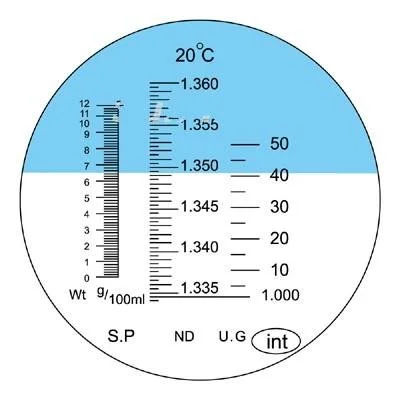Measuring urine S.G.
Equipment:
- Urine sample (in a sterile and correctly labelled container)
- Distilled water (in a dispensing bottle)
- Paper towel
- Clinical refractometer
- Disposable pipette
- Clinical waste bin
- Sharps bin (if using a glass pipette tip)
- Refuse bin
- Disposable gloves
- A means of recording the result
Ensure the refractometer is correctly calibrated before use by ensuring that distilled water gives a reading of 1.000 on the S.G. scale.
Pat the prism dry with paper towel to remove the water before adding the urine (otherwise your sample will be diluted and so give an artifically low result).
MIX THE URINE SAMPLE BEFORE YOU MEASURE THE S.G.!!
Think about why mixing is necessary: remember that urine is a suspension. It consists of particles such as crystals, casts etc. suspended (floating) in a liquid (the solute). The more particles there are in a liquid, the higher its refractive index (and hence its S.G. result on a refractometer) will be.
Once a urine sample has been collected, placed in a container and left to stand all these particles will start to fall to the bottom of the container (like a snow globe). If you then come along and remove a few drops of urine from the top of the container it will contain hardly any particles. When placed on the refractometer prism the absence of the particles will result in a lower S.G. reading than is actually the case.
If you then go and report this incorrect result back to your vet they will have no way of knowing that you didn't perform the test correctly and the result is inaccurate. The vet will go ahead and make a diagnosis and treatment plan based on incorrect information. This is potentially very harmful for the animal!
You must mix every urine sample thoroughly by fully inverting it at least five times before you take a S.G. reading (video 1). Avoid shaking or otherwise handling the sample roughly, as this can damage any cells it might contain.
Video 1. Mixing a urine sample.
Pipette a few drops of the sample onto the refractometer and close the cover. Hold it up to the light and read off the result from the U.G. scale. If the figures are blurred twist the eyepiece to focus the refractometer and obtain a clear view. Read the result from the line where the blue and clear areas meet. If you look at figure 1 the reading shown in this case is a specific gravity of 1.041 (remember there are no units as S.G. is a ratio).
Figure 1. Urine specific gravity reading of 1.041
Rinse the urine off the refractometer and pat it dry with paper towel before returning it to its case, ready for the next use. Video 2 shows how to obtain a urine specific gravity reading in full, as part of a complete urinalysis.
Video 2. How to measure urine S.G.
Tips for accurate urine S.G. results:
- If the sample was refrigerated allow it to come to room temperature before testing.
- Ensure that you are using the correct scale(!).
- Ensure that distilled water is reading 1.000 on the correct scale before testing.
- Ensure the urine sample is well mixed before testing it.
Figure 2. Typical specific gravity results of domestic species (adapted from Sirois, 2015, p.161).
Increased urine S.G. is associated with dehydration, shock, acute renal failure, reduced water intake and/or increased fluid loss e.g. vomiting, panting, sweating or diarrhoea, as well as increased excretion of urine solutes (such as glucose in cases of undiagnosed or poorly controlled diabetes mellitus).
Reduced urine S.G. is associated with increased fluid intake (polydipsia), overzealous administration of fluid therapy. Diseases that reduce the ability of the kidney to reabsorb water (pyometra, diabetes insipidus, some liver conditions, kidney disease) will result in low S.G., as will the administration of diuretic drugs.
Isothenuria occurs when the urine S.G. is the same as that of the glomerular filtrate (1.008-1.012). This indicates renal disease severe enough to result in the loss of the ability to concentrate or dilute the urine e.g. chronic renal failure. Even if these animals are deprived of water, their urine S.G. will not rise. Animals with less severe renal disease may have moderate but persistent dehydration and a urine S.G. that remains slightly higher than isothenuria (1.015-1.020).
If the urine is very concentrated:
Very concentrated urine samples (e.g. those from dehydrated animals) may exceed the maximum limit of the refractometer scale. If this happens:
- Mix equal quantities of the urine sample with distilled water in a sterile container.
- Measure the specific gravity a drop of this mixture.
- Multiply the last two digits of the result by 2 to obtain an estimated S.G. of the original sample.
- For example, if the diluted sample gives a result of 1.032 then the S.G. is estimated to be 1.064 (32 x 2).
Why not just use the S.G. result from a dipstick?
Most commercial reagent strips for a complete urinalysis test include a S.G. pad. However this method is unreliable for veterinary patients.
- The strip S.G. is based on a pH indicator controlled colour change and inaccurate results are common if the urine pH is >6.5
- The highest S.G. reading the strip can measure is only 1.030 but dogs, horses and cats frequently produce urine that is more concentrated than this.


